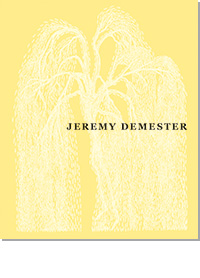Künstlerbücher / Special Editions
Almond, Darren / Blechen, Carl: Landschaften
Brown, Glenn: And Thus We Existed
Butzer, André: Exhibitions Galerie Max Hetzler 2003–2022
Chinese Painting from No Name to Abstraction: Collection Ralf Laier
Choi, Cody: Mr. Hard Mix Master. Noblesse Hybridige
Demester, Jérémy: Fire Walk With Me
Dienst, Rolf-Gunter: Frühe Bilder und Gouachen
Dupuy-Spencer, Celeste: Fire But the Clouds Never Hung So Low Before
Ecker, Bogomir: Man ist nie Alone
Elmgreen and Dragset: After Dark
Förg, Günther: Forty Drawings 1993
Förg, Günther: Werke in der Sammlung Friedrichs
Galerie Max Hetzler: Remember Everything
Galerie Max Hetzler: 1994–2003
Gréaud, Loris: Ladi Rogeurs Sir Loudrage Glorius Read
Grosse, Katharina: Spectrum without Traces
Hatoum, Mona (Kunstmuseum
St. Gallen)
Eric Hattan Works. Werke Œuvres 1979–2015
Hattan, Eric: Niemand ist mehr da
Herrera, Arturo: Boy and Dwarf
Hilliard, John: Accident and Design
Horn, Rebecca / Hayden Chisholm: Music for Rebecca Horn's installations
Huang Rui: Actual Space, Virtual Space
Kowski, Uwe: Gemälde und Aquarelle
Mikhailov, Boris: Temptation of Life
Mosebach, Martin / Rebecca Horn: Das Lamm
Neto, Ernesto: From Sebastian to Olivia
Oehlen, Albert: Spiegelbilder. Mirror Paintings 1982–1990
Oehlen, Albert: unverständliche braune Bilder
Oehlen, Pendleton, Pope.L, Sillman
Oehlen, Albert | Schnabel, Julian
Phillips, Richard: Early Works on Paper
Riley, Bridget: Gemälde und andere Arbeiten 1983–2010
Riley, Bridget: Die Streifenbilder 1961–2012
Riley, Bridget: Paintings 1984–2020
True Stories: A Show Related to an Era – The Eighties
Wang, Jiajia: Elegant, Circular, Timeless
Wool, Christopher: Westtexaspsychosculpture
Zhang Wei / Wang Luyan: Ein Gespräch mit Jia Wei
 |
|
|||
| Jeremy Demester Text Jean-Marie Gallais Englisch / Französisch Hardcover 24 x 29 cm 168 Seiten 104 Farbabbildungen 978-3-947127-44-3 40,00 Euro
|
Als der Künstler Jeremy Demester 2015 nach Ouidah im westafrikanischen Benin reiste, fand er dort unerwartet einen Resonanzraum für seine Kunst. Die Beschäftigung mit Voodoo-Kult und lokaler Kultur war voller Verbindungen und Parallelen zu den eigenen Tsigane-Wurzeln und gab ihm neue Zeichen und Gestalten, die sich in Gemälden und Skulpturen immer konkreter manifestierten. Das Buch dokumentiert vier Ausstellungen in der Galerie Max Hetzler Berlin und London sowie im Musée de la Fondation Zinsou in Ouidah, die nachvollziehbar machen, wie Demesters Werke fremde Motive aufnehmen, um eine ganz individuelle Sprache für allgemein menschliche Themen zu entdecken: Gesichter geisterhafter Figuren füllen Leinwände komplett aus, Naturkräfte manifestieren sich in überraschenden Farbkontrasten, Kollaborationen mit lokalen Künstlern finden einen festen Rahmen und selbst die Abstraktionen sind von totemhafter Kraft. Die ganz elementaren Fragen, die diese Werke stellen – Wo kommen wir her? Wo stehen wir jetzt? Wer sind wir? – beleuchtet ein einfühlsamer Essay von Jean-Marie Gallais, der uns zeigt, was diese künstlerische Begegnung der Kulturen von beiden Seiten bedeutet und wie der Künstler von einem „der seine Gedanken auslebt“ zu einem, „der seine Bilder in Bewegung setzt“ wurde.
BADJI ROUROU When Demester arrived for the first time on the red earth of Ouidah, he did not know what to expect and had brought nothing with him. He followed his intuition, allowing himself to be guided by his encounters, by the burden of history attaching to the places he discovered, and by the orality so universally present in Benin. His outlook was that of a Western artist, but also of a Romani particularly open to other ways of perceiving the world and of producing images. He very soon felt the need to paint. But what? And how? In the local market, he found pigments amidst the oils, substances and powders sold for ritual use. Looking for large-format canvases, all he could find was the shrouds used by the Islamic community of the city. He explored the full significance of the sacred, in this case Western African beliefs and rituals such as they are manifested in Benin in general and at Ouidah in particular. This occurred at a time when Demester was, like many before him, seeking to purge himself of some of the pictorial influences imparted by his artistic education in order to allow a new language to emerge. In order to “relearn how to paint,” Demester had, in earlier works before his departure for Africa, begun what one might perhaps describe as exercises, notably taking on fundamental subjects that run through the entire history of art, painting the elements sky, fire and liquid, and molding earth in his hands. Rather than in the heavily codified field of the Fine Arts, he learned innovation and expertise from other kinds of painters: decorators, industrial painters and experts in military camouflage and technical pigments. Artists must, he feels, free themselves from their own specialism. The African context seemed from the outset to favor this step. The primary indicator of this new language expressed in what the artist calls his “African paintings” is visible at first glance: the flamboyant color used by Demester to divide the picture spatially. He is, paradoxically, color blind and often speaks of the moment when, as a schoolchild, he became aware of this difference. For him, colors are words as much as tints or shades and he approaches them through their denomination. In this way, he quickly came to understand that parallel worlds could coexist: the visible world and an abstract one, the world of words—and literature became a faithful ally in his creative process. Consequently, “painting without seeing” has formed the central principle of his self-reinvention. This has meant asking scientists to determine the color of the blood in our veins, asking children to wave canvases coated with living matter and to dance with them, letting pictures be struck by lightning, or letting nature have its way with canvases rolled around trees, hung up in the wind, or left to the tender mercies of the rainy season. “Painting without seeing” means opening doors, leaving his work to be re-touched by the invisible and impregnated with the non-material. As a rule, this procedure goes hand-in-hand with the effort to transcend reason and advance into the spiritual …
… |